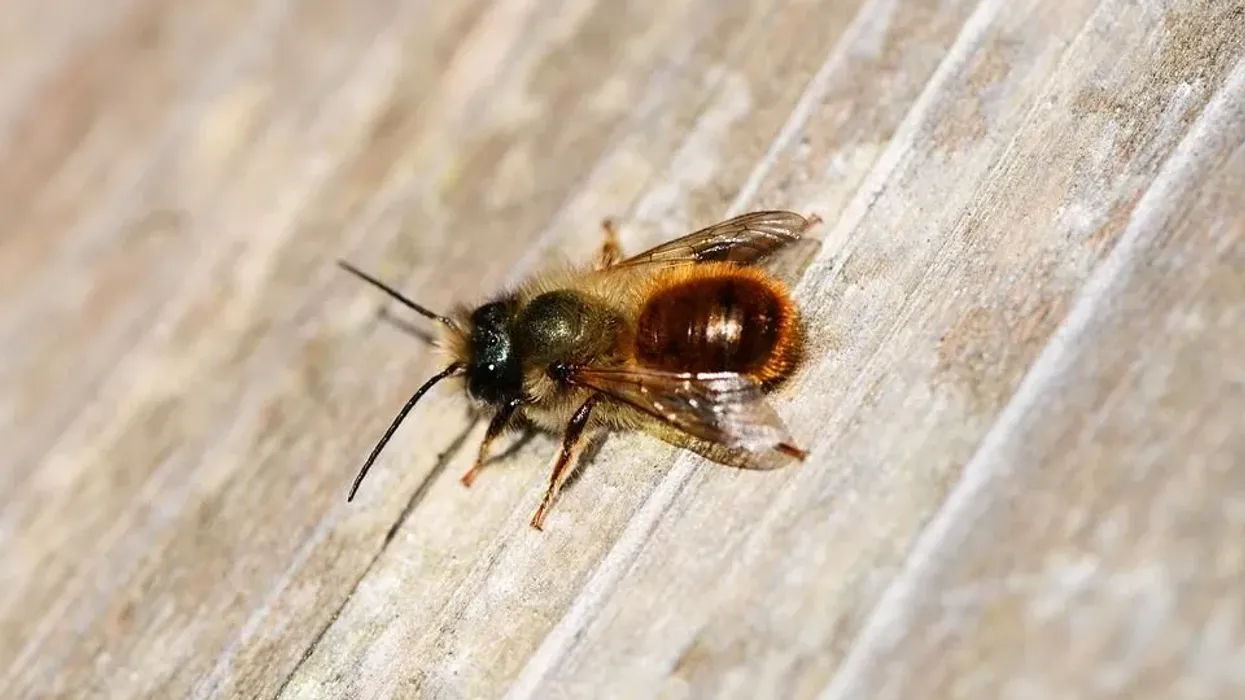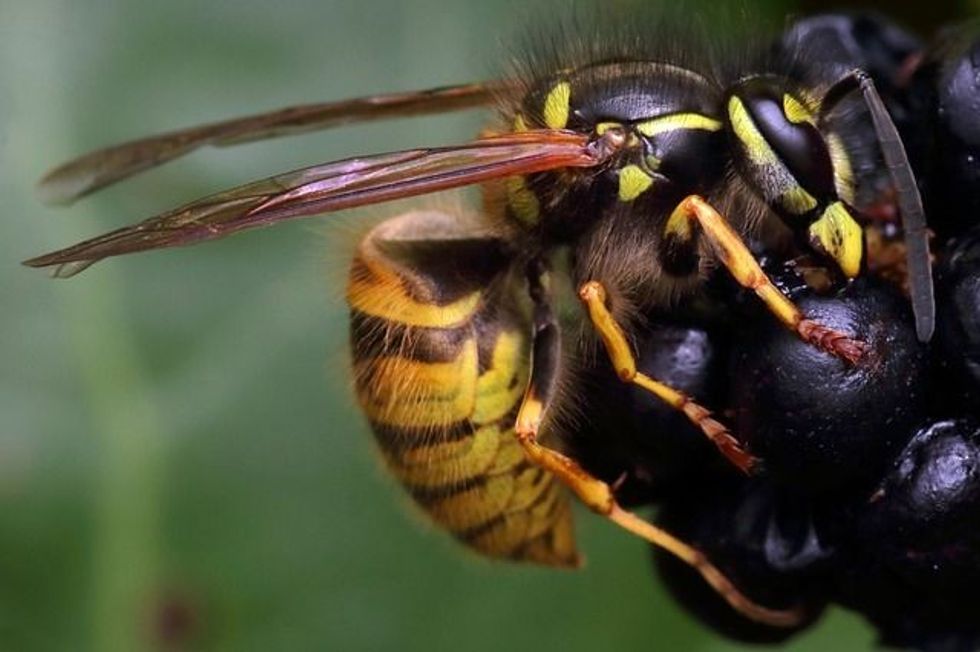Usually, a regal blue, green, and black in color, mason bees are gentle and happy to lend a helping hand in the growth of your gardens. They are master pollinators, who are known for being responsible for pollinating flowers a lot more than honey bees.
The best part? They do not even sting. Native to most continents in the world, namely, Asia, South, and North America, and Europe, there are more than 300 species of these bees buzzing throughout their geographical range.
With geographic differences, there is a slight difference in the colors of these creatures. While most of them are the usual blue-black, some have been known to possess a rusty red color on their back. They spend a full year as larvae and only come out of their cocoons in spring as adults.
Want to know more about them? We suggest you keep reading on.
If you like reading articles about animals, please check out our carpenter bee facts and European honey bee facts.
Mason Bee Interesting Facts
What type of animal is a mason bee?
Mason bees are a type of bee, known as such because of their habit of using wet soil or other such masonry items to procure their nests. They are also called the blue orchard bee for their skills in pollinating fruit trees.
What class of animal does a mason bee belong to?
Like all bees in existence, the mason bees are also insects, belong to the class Insecta, which feed on pollen and nectar. They are unique in their nesting habits, as they are the only types of bees who use mud and other types of masonry items to build and protect their nests.
This is why they are known for nesting in cavities of mountains, cliffs, and the hollow parts of trees.
How many mason bees are there in the world?
It is hard to say just how many mason bees are there in the world, but, there are known to be more than 300 species of mason bees buzzing around their native lands. These pollinators are unique as they unlike honey bees they do not make honey, instead collect pollen and nectar for their individual nests.
They are also solitary bees who do not have a prominent social structure with a queen ruling over them.
Where does a mason bee live?
These gentle bees are native throughout most of the continents, like Asia, South America, North America, as well as in Europe.
What is a mason bee's habitat?
Mason bees do not carve their own nests and choose to inhabit a natural cavity like a hollow tree, snail shell, or mountain crevices. They collect pollen as food for the larvae, thus helping in the pollination process, and use mud, grit, or clay to make individual cells before sealing them up.
Who do mason bees live with?
Mason bees are mostly solitary bees, and they do not live in groups. When leaving their cocoons, the males are known to emerge first, and then the females.
The females can mate with several males, after which the males tend to die and the females go on a hunt for new nests. They use mud, plant tissue, or even flower petals in the case of some species to line their nests and make individual cells.
How long does a mason bee live?
The male bees of this species are known to die soon after emerging from their cocoons and mating with the females, while the females are known to die after laying the eggs, which makes their lifespan about four to six weeks on average.
How do they reproduce?
Their breeding season starts in early spring, soon after they emerge from their cocoons where they spend the entire summer and winter season hibernating and evolving in the cocoons.
The males emerge first as the male eggs are laid at the front of the nesting holes and the female eggs at the back. The females mate with several males after they emerge from the nesting holes after which the males unfortunately die.
The females go on a hunt for new nesting cavities soon after.
As this blue orchard bee is known to be a species of solitary bees, they do not carve their own nesting holes, rather colonizing natural holes like hollow trees, mountain crevices, and even snail shells on occasion. They gather pollen, nectar, and other things for the nesting holes and their egg on top of them.
The reason why these bee populations are beneficial for your garden is they are master pollinators, and they pollinate fruit trees, flowers, and plants a lot more than honey bees.
These unique pollinators can lay female eggs without being fertilized.
The female bees lay about one or two eggs per day with a total amount of about 10-15 eggs before they are done. The nest usually holds five to eight egg cells, and the female seals the entrance of each cell with clay, mud, plant tissue, or even with petals of flowers after they fill up.
This entire process is completed within a few weeks in the early spring season, as the female Mason bees die after the egg-laying process is completed.
What is their conservation status?
One species of the mason bees, Osmia bicornis, is listed as of Least Concern in the IUCN Red List of Threatened Animals, while most others are not listed, so it can be assumed that these pollinating bees are still thriving in their natural habitat.
However, the bee population worldwide is under immense stress as their numbers are declining due to the loss of habitat.
Mason bees are extremely beneficial for your garden, so it would possibly be a good idea to start conservating them right away before they too fall under threat.
Mason Bee Fun Facts
What do mason bees look like?

Mason bees are small bees, similar to sweat bees. Even though they are similar in shape to the honeybee, they are smaller in size.
There are more than 300 species in the Osmia family, and they more or less have a similar appearance. The native bees from North America, though, have a slight difference in their coloration.
While most mason bees are black with a metallic blue-green color on their back, the native bees from North America are known to have a rusty red color on their back.
They do not produce honey, do not carve their own nest rather living in wood tubes or natural cavities. They are used to far chilly temperatures than the honeybee populations worldwide, even though they spend the entire summer and winter season hibernating inside their nest.
The female mason bees pile the nest with pollen and nectar for individual egg cells before they seal the tubes with clay, mud, or chewed plant tissues. Mason bees are known to pollinate fruit trees a lot more than other types of bees.
How cute are they?
Rather than cute, they look almost regal with their metallic blue-green and black colors. Some members of this species also have a rusty-red back instead of the usual blue-green.
They are known to pollinate trees and plants at high speed which helps your garden a lot.
They are also solitary, so you will not have to think about keeping a colony of bees in your bee house. Another interesting fact is that they can adapt to a lot of different types of nests if they have habitable tubes and cavities.
How do they communicate?
Mason bees are known for communicating with their own kind through chemical cues and physical gestures.
How big is a mason bee?
Mason bees are a small species of bees, with adults growing only about 0.4-0.6 in (10.2-15.2 mm) on average. In comparison, the stingless bee grows to around 0.15-0.27 in (4-7 mm).
How fast can a mason bee fly?
They are small bees, and they are known for pollinating trees like fruit trees, and other types of plants at a high speed, so it can be assumed that they can fly at quite a high speed for such a small creature.
Honey bees can fly at a speed of about 15 mph (24.1 kph), so it can be assumed that mason bees can fly more or less around that speed as well.
How much does a mason bee weigh?
It is hard to say just how much mason bees weigh, as weighing a live, buzzing bee would be quite troublesome. However, they are small, so it can be assumed that they do not weigh much. Their weight is also highly dependent on their habitat, nest size, and the availability of food items like pollen and nectar.
What are the male and female names of the species?
Like most other types of wild bees, the spring mason bees do not have sex-specific names. They are just known as male mason bees and female mason bees.
What would you call a baby mason bee?
Like all types of bees, the babies of the mason bees are called larvae. They stay hiding and hibernating inside their cocoons until they are ready to come out as adults.
What do they eat?
Like most other types of bees, the spring mason bees only feed on pollen and nectar, which they also pile up on their nest as food before they lay the eggs and seal up the wood tubes with clay, mud, and sometimes even with flower petals.
They are only active during the spring, as they emerge from their nest during this time and die within a few short weeks.
They manage to pollinate trees like fruit trees and flower plants within these short weeks.
Are they dangerous?
They are not dangerous at all, as they are not known for stinging. In fact, they seem to be quite a gentle species of bee that can help your garden grow very fast as they pollinate a lot during their short lifespan.
Would they make a good pet?
The spring mason bees make excellent pets as they are gentle and do not really sting.
Mason bees nest in any natural cavity like a hollow tree, and wood tubes where they make cells by lining them with mud, clay, plant tissue after piling it pollen, nectar, and other plant materials as food for the larvae, which helps in the pollination of the plants.
They spend a full year as larvae hiding throughout summer and winter in their cocoons before they emerge from their nest in the spring.
Did you know...
The mason bees, native to most continents, help a lot in the pollination of plants.
Do masonry bees make honey?
Unlike honey bees, mason bees do not make honey. Rather, they collect pollen, nectar, and other plant materials as food for the larvae and help in the pollination of the plants.
Are mason bees the same as carpenter bees?
No, carpenter bees and mason bees are completely different species. Carpenter bees are larger in size than the mason bees, with some species growing as big as bumblebees. The carpenter bees have a smooth abdomen while the mason bees have a hairy abdomen. Carpenter bees belong to the genus Xylocopa while the mason bees belong to the genus Osmia.
Here at Kidadl, we have carefully created lots of interesting family-friendly animal facts for everyone to discover! Learn more about some other animals including money spider facts and striped bark scorpion facts.
You can even occupy yourself at home by coloring in one of our free printable mason bee coloring pages.










